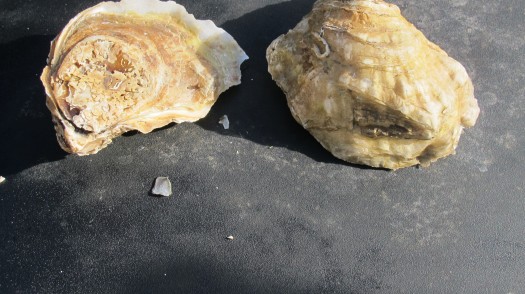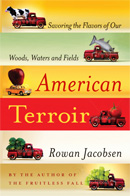Forbidden Oysters
Oct 18, 2012
Forbidden Oysters are making quite a splash in the Maryland/Virginia region, and rightfully so. They are so delicious that (this may get me in trouble) they don’t taste like Chesapeake oysters at all. They are saltier than other Chesapeake oysters I’ve had, while still not being as punishingly, bitter salty as Chincoteagues and others that are grown on the Atlantic side of the Eastern Shore. The moderate salt is perfectly balanced by an irresistible sweetness and an instantly and unmistakably recognizable flavor of artichoke leaves dipped in butter sauce. Really, extraordinary flavor.
They don’t look like Chesapeake oysters, either. Note the umber and sienna tones to the shells:

That’s something I’ve seen in Narragansett Bay oysters and very few others. I don’t know if it means anything, if it might be associated with a particular alga or mineral in the area, but it’s a sign of something unusual going on. The oysters were also quite plump, unlike most I’ve had from the Chesapeake lately. The reason is that they are triploids. Basically, they have three sets of chromosomes, which makes them sexless, so instead of ever switching to reproductive mode, they just feed and fatten year-round, like a gelded steer. (Don’t let this freak you out; a lot of your vegetables are triploids, too, and Pacific oyster farmers have been using triploids for years.) Anyway, if these are any indication of what triploids can do in the Chesapeake, I’m all for it.
The oysters are grown by Greg Garrett, whose family has been gnoshing on Chesapeake oysters since Jamestown, more or less. The site is near where the York River meets the bay, and York River oysters have been well-regarded for centuries. Garrett had to fight through a morass of government permits to get the rights to farm the oysters, and this is perhaps the root of the name, although naughty double entendre also never hurt the sales of an oyster (see Cowboy, Naked).
« PREVIOUS: BBQ Oyster Grill
 Recent Posts
Recent Posts

3 Responses to Forbidden Oysters